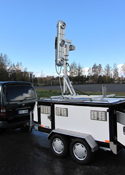
New Test Equipment Enhances Police Traffic Surveillance
Police surveillance of seatbelt compliance and speeding receives a boost with the new test equipment. Developed by VTT Technical Research Centre of Finland, the equipment also measures distance between vehicles, road surface condition and calculates traffic emissions. The test equipment is part of an EU project aimed at improving traffic safety and reducing accidents caused by traffic rule violations. The technical test phase will continue until the end of next year, after which part of the equipment will be ready for production.
The equipment, based on automatic camera surveillance and wireless network connection, is handily located on a mobile trailer unit. The police are thus able to monitor traffic and impose penalties for violations more comprehensively and fairly. The monitoring information is gathered into a common database available to the police, road operators and environmental authorities. A pilot system has been launched in Tampere enabling the police to test the equipment.
The aim is to develop the test equipment to match police requirements as closely as possible. The database is strictly protected by firewalls and technical solutions. The equipment automatically destroys images over one month old and those in which no traffic violation is evident. After the test phase the surveillance technology can be transferred from the test trailer to police vehicles. VTT estimates that the full technology will be ready for commercializing in 2013.
The total budget for the ASSET project (Advanced Safety and Driver Support for Essential Road Transport) is EUR 8.2 million, mostly funded by the European Commission.
The EU project runs a total of four test sites, the other three being located in Germany, France and Austria. The budget for the Finnish test site is approximately EUR 270,000. VTT Technical Research Centre of Finland is responsible for the development of the Finnish test equipment in cooperation with service operator Emtele Oy and National Traffic Police.
Consortium partners -- a blend of universities, research institutes, businesses and end users -- number 19 in all, come from Europe, Tanzania and India. The three-year project is set to close at the end of next year.